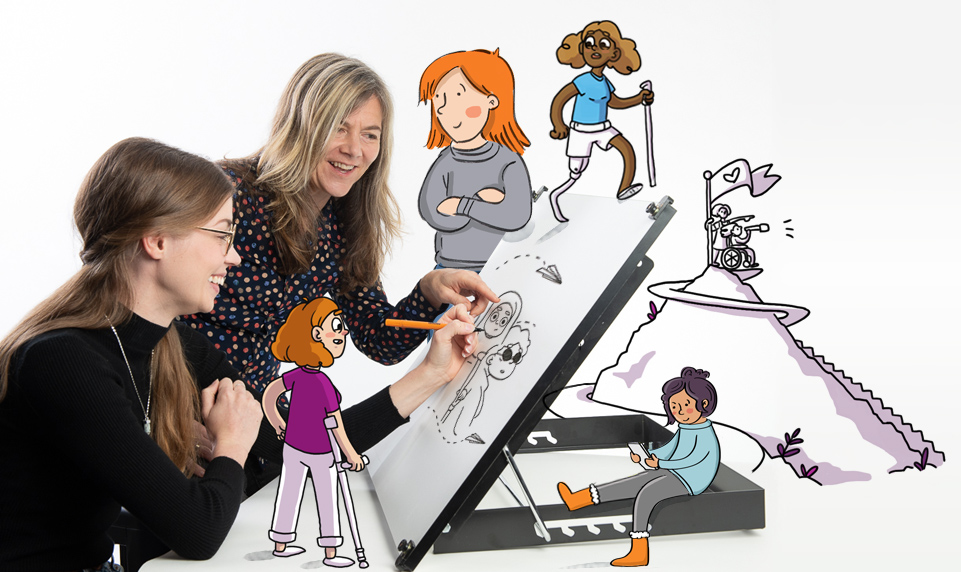If you’re new to the world of creating explainer videos, read this first. It introduces the basics and makes a strong argument for why an explainer video can supercharge your messaging.
This article focusses on the how—a peek behind the curtain at our process for making a compelling video.
Conceptualisation
Too often, creators jump straight into visualisation mode (which is often perceived as the “fun”, creative part of the process) without putting enough thought into what to draw.
Understanding your audience—articulating their problems, assumptions, hopes, and fears—leads to insights and authentic stories that can form the backbone of your script. Likewise, defining the scope of what you want to communicate, as well as the response you’d like your audience to have to the video, is crucial for creating a script that delivers the outcome you’re after. At Sketch Group, we have a workshop that we run called an Empathy Forecast. It’s the best way to achieve all of the above, and is the cornerstone of our process.
Scriptwriting
If you’ve successfully workshopped the concept for your video and elicited the insights about your audience and the responses you’d like them to have, you should now have:
- a handful of key messages and phrases that you know will resonate with the audience
- some evidence to validate your message or give it credibility, and
- a collection of stories that humanise those data points.
For a professional copywriter, pulling all of these together into a compelling narrative is a fairly straightforward exercise, as they have all of the ingredients. They just need to get cooking!
Storyboard Creation
Now comes the fun part—creating a storyboard. This is where the illustrator takes your script and begins crafting imagery to bring it to life. The end product looks much like a comic book—a series of frames that indicate what imagery will be on screen when each part of the script is being voiced. More than just a collection of pictures, an effective storyboard for an explainer video will:
- create a character (or a cast of characters) who reappears throughout the script, to bring an element of visual storytelling
- strike the right balance of image to word density. Too much detail on screen for a short time will result in the viewer feeling rushed or dizzy; too little action on screen for a long time and the viewer will become bored
- use a consistent style throughout
- use colour sparingly—often two or three brand colours, combined with black line art and a grey shade is sufficient to create a “whiteboard animation” effect with additional depth for visual interest
Video Shoot
At Sketch Group, we almost always work analogue to shoot our video. While there is software that simulates a hand drawing on screen, we believe that this approach looks fake (because it is) and prefer the authentic “performance” nature of filming a real hand drawing on a real canvas.
Your illustrator will take their time, slowly inking each of the frames you’ve signed off on, while the camera rolls. This process will often take a whole day to shoot every frame. Once complete, we have al of the raw footage we need, and can begin editing.
Animation Techniques
There is a range of techniques that can be applied to animate a storyboard. At the simple end of the spectrum, we’ll use professional video editing software like Adobe Premiere to speed up the footage and synchronise key parts of the imagery to the voiceover, punctuating key words and reinforcing concepts with matching imagery. At the more sophisticated end of the spectrum, we’ll use a professional motion graphics software like After Effects to take the existing imagery and move it around on screen. Where a video sits on this spectrum will directly influence how long a video takes, and how much it will cost.
Audio Recording
While occasionally some clients may insist on recording their own voiceover, in our experience using a professional voice talent will always result in a far superior product. At Sketch Group we have a library of regular voiceover artists that we call upon for our client videos. Their skill at embodying the voice of the script, their responsiveness at delivering high quality voiceover tracks, and the diverse range of different styles means our clients are always delighted with the result!
The music and sound effects that we apply to your video bring another dimension to the viewer experience. Subtle chimes, background chatter, and other snippets of real-world sounds all combine to create an immersive audio tapestry.
Distribution and Promotion
“Build it and they will come!” … said no successful marketer, ever. The success of your video is as much dependent on how good it is as how much you shout from the rooftops about it. If it’s an internal video being posted to your company intranet, be sure to liaise with the intranet manager to get it pinned or featured; encourage your own team to leave comments on the post; send an email to the target audience driving them to the video; and ensure your leadership team also reference it in the communications that they send out.
For public facing videos, a similar strategy is needed: publish it to multiple social media channels, and encourage your network to like, comment, and share the post; be sure to feature it in customer newsletters; highlight it in a blog post on your organisation’s website; negotiate for it to be promoted on industry websites and forums; and work with your marketing team to invest in a paid advertising campaign to drive traffic to the video.
Case Studies
At Sketch Group, we have a plethora of examples to demonstrate how this approach is successful at creating impactful videos that cut through and drive a desired outcome.
National Museum of Australia
The National Museum of Australia received funding to create a series of videos celebrating the “100 defining moments” in Australia’s history. We brought seven of these fascinating moments to life with an explainer video. Read the full National Museum of Australia case study here.
BioMelbourne Network
BioMelbourne Network needed help explaining to the government, its partners, and the biomedical industry the fundamental role of the organisation and the value that it offered. Our explainer video captured this in a nutshell. Read the full BioMelbourne Network case study here.
Fire Films
Fire Films is an award-winning production company that specialises in science and health documentaries. We partnered with them to create an effective training module for caregivers and medical professionals about when and why patients might need to have their medication deprescribed. Read the full Fire Films case study here.
Conclusion
If you’re beginning your journey of creating an explainer video, we’d love to chat. Check out our dedicated Explainer Videos page, or browse more of our case studies. When you’re ready, click the Get a Quote button at the top of the page, fill out some basic information about your project, and we’ll be in touch!


